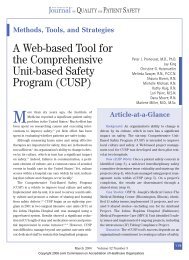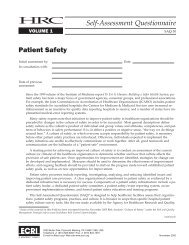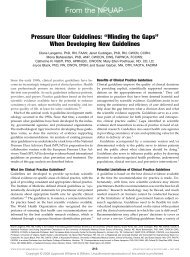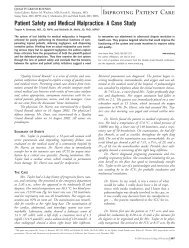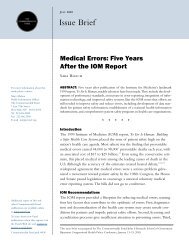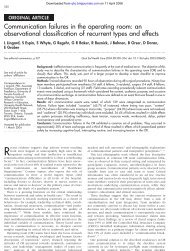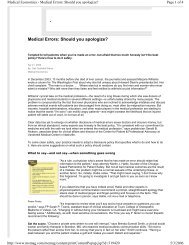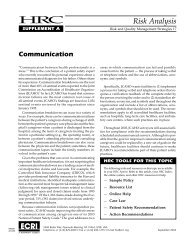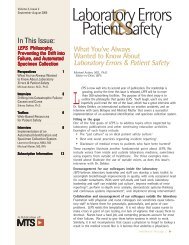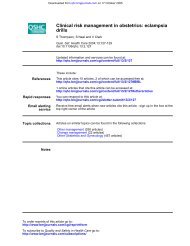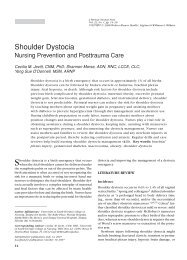Chain of Command - MCIC Vermont Patient Safety Documents
Chain of Command - MCIC Vermont Patient Safety Documents
Chain of Command - MCIC Vermont Patient Safety Documents
Create successful ePaper yourself
Turn your PDF publications into a flip-book with our unique Google optimized e-Paper software.
SUPPLEMENT A<br />
Risk Analysis<br />
Risk and Quality Management Strategies 19<br />
<strong>Chain</strong> <strong>of</strong> <strong>Command</strong><br />
In healthcare, chain <strong>of</strong> command has been defined as a<br />
“specific course <strong>of</strong> action involving administrative and<br />
clinical lines <strong>of</strong> authority established to ensure effective<br />
conflict resolution in patient care situations.” 1 Appropriate<br />
chain-<strong>of</strong>-command policies and procedures are crucial<br />
to patient safety in all healthcare settings, but<br />
especially in acute care institutions and facilities where<br />
patients are most at risk for an acute condition to develop<br />
or where an emergency situation is likely to arise and require<br />
intervention. In its Risk Management Program Development<br />
Tool Kit, the American Society for Healthcare Risk<br />
Management (ASHRM) recommends that organizations<br />
develop policies and procedures on chain <strong>of</strong> command<br />
for intervention during “any event or situation that does<br />
not meet established guidelines or which may place a patient<br />
at risk.” 2<br />
Indeed, improvement and strengthening <strong>of</strong> the chain<br />
<strong>of</strong> command was cited as a key component <strong>of</strong> a measurable<br />
and successful effort to improve systems and processes<br />
related to patient safety at a large tertiary hospital. 3<br />
Some <strong>of</strong> the results <strong>of</strong> this overall effort included a reduction<br />
in adverse drug events, as well as in ventilatoracquired<br />
pneumonias and central-venous catheter-related<br />
blood stream infections. The effort also resulted in a significant<br />
decrease in the registered nurse vacancy rate. 4<br />
Because the delivery <strong>of</strong> patient care at times involves<br />
differences <strong>of</strong> opinion and conflicts in clinical practice,<br />
healthcare institutions must provide a means <strong>of</strong> resolution<br />
for the individuals involved in order to provide safe<br />
care to patients. This Risk Analysis explains the purpose<br />
<strong>of</strong> a chain-<strong>of</strong>-command policy and <strong>of</strong>fers recommendations<br />
for policy content, describes the conditions under<br />
which chain <strong>of</strong> command should be invoked, reviews liability<br />
claims involving chain <strong>of</strong> command, and proposes<br />
strategies for implementing a chain-<strong>of</strong>-command policy.<br />
Purpose <strong>of</strong> a <strong>Chain</strong>-<strong>of</strong>-<strong>Command</strong><br />
Policy<br />
Differences in pr<strong>of</strong>essional knowledge and skill levels,<br />
as well as differences <strong>of</strong> opinion, can contribute to patient<br />
care conflicts between physicians and hospital staff.<br />
While the physician bears the responsibility for medical<br />
decision making, other members <strong>of</strong> the healthcare team,<br />
such as nurses, have a duty <strong>of</strong> care that includes advocacy<br />
for the patient. Nurses in particular are held pr<strong>of</strong>essionally<br />
accountable for their own actions and have a duty to<br />
intervene when medical care does not appear to meet the<br />
standard <strong>of</strong> care.* This is especially true in hospitals and<br />
other healthcare facilities where clinical situations <strong>of</strong>ten<br />
compel caregivers to act quickly and decisively to meet<br />
the patient’s needs. Failure to do so can constitute a<br />
breach <strong>of</strong> duty and consequent patient harm and result in<br />
a legal determination <strong>of</strong> negligence. (For related information,<br />
see the Risk Analysis “An Overview <strong>of</strong> Nursing Liability,”<br />
located elsewhere in your Healthcare Risk Control<br />
[HRC] System.) Indeed, liability claims against healthcare<br />
facilities <strong>of</strong>ten result from failed chain-<strong>of</strong>-command.<br />
The purpose <strong>of</strong> a chain-<strong>of</strong>-command policy is to<br />
• resolve a conflict involving patient care,<br />
• clarify a care management plan,<br />
• obtain a necessary patient care intervention,<br />
* The term “standard <strong>of</strong> care” is a legal term <strong>of</strong> art that differs among<br />
jurisdictions. Generally, the standard <strong>of</strong> care is the duty to treat patients<br />
with the reasonable diligence, skill, competence, and prudence as is<br />
practiced by minimally competent pr<strong>of</strong>essionals in the same specialty<br />
or general field <strong>of</strong> practice. (For more information on this topic, see the<br />
Risk Analysis “A Legal Primer,” located elsewhere in your Healthcare<br />
Risk Control System.)<br />
HRC TOOLS FOR THIS TOPIC<br />
The following tools and resources on this topic are<br />
available in your HRC System. Refer to this article, your<br />
HRC Index, the HRC Members’ Web site, and other HRC<br />
resources for help.<br />
— Case Law<br />
— Sample Policy<br />
— Action Recommendations<br />
— Also Available on HRC Web Site<br />
492587<br />
424-005<br />
A NONPROFIT AGENCY<br />
5200 Butler Pike, Plymouth Meeting, PA 19462-1298, USA<br />
Telephone +1 (610) 825-6000 • Fax +1 (610) 834-1275 • E-mail hrc@ecri.org September 2004
2 Healthcare Risk Control<br />
Failure to Pursue Physician Bedside Evaluation<br />
A 70-year-old female patient with asthma who was<br />
hospitalized for major depression on a psychiatric unit<br />
developed progressive respiratory difficulties leading<br />
to acute respiratory failure that necessitated intubation<br />
and admission to the intensive care unit (ICU). She ultimately<br />
recovered after several weeks <strong>of</strong> hospitalization<br />
and rehabilitation following discharge.<br />
Allegations in a liability suit brought by the patient included<br />
failure to monitor, failure to timely contact the<br />
physician, and failure to take aggressive action. The<br />
case was settled before trial by the hospital and the physician.<br />
The sequence <strong>of</strong> events is summarized below.<br />
• At 7 p.m. on the second day <strong>of</strong> her psychiatric admission,<br />
the patient developed shortness <strong>of</strong> breath and<br />
expiratory wheezing, unrelieved by her Proventil inhaler.<br />
Also, mild edema <strong>of</strong> the right ankle had increased<br />
significantly from earlier in the day.<br />
• At 7:30 p.m., the covering medical physician was<br />
notified and the patient was treated with a diuretic<br />
and a nebulizer, which were ineffective.<br />
• At 10:30 p.m., oxygen was applied and Ativan was<br />
administered, which were also ineffective, as the<br />
patient stated that she could not breathe.<br />
• At 11:30 p.m., the physician was notified and arterial<br />
blood gases (ABGs) were ordered, as were additional<br />
respiratory treatments, and then repeat<br />
ABGs. Initial ABGs showed hypercarbia and hypoxia,<br />
but following the respiratory treatments, the<br />
levels improved slightly.<br />
• Although tachypnic, the patient calmed down and<br />
rested between 1 and 3 a.m.<br />
• At 3:30 a.m., the patient again experienced respiratory<br />
distress and the physician was again notified.<br />
Sketchy documentation and missing records make<br />
it difficult to ascertain what, if any, interventions<br />
took place until another nursing entry an hour later,<br />
at 4:30 a.m., when the patient was described as being<br />
diaphoretic and having increased respiratory<br />
distress.<br />
• At 5:30 a.m., the physician was called again. The patient<br />
was taken to the emergency department where<br />
she was intubated during cardiopulmonary arrest,<br />
stabilized, and then transferred to the ICU.<br />
HRC Commentary: When the patient’s condition was<br />
clearly becoming worse and the physician did not come<br />
in to evaluate her, the psychiatric unit nurses and staff<br />
had a duty to aggressively pursue bedside medical<br />
evaluation. Additional calls to the physician were warranted<br />
in this case, as was utilization <strong>of</strong> the chain <strong>of</strong> command<br />
as necessary to obtain medical examination by a<br />
physician. Instead, the patient was allowed to remain in<br />
distress for several hours, which delayed appropriate<br />
management <strong>of</strong> her respiratory distress. The physician<br />
also under treated the patient at the time <strong>of</strong> the second<br />
notification at 11:30 a.m., when drug therapy (steroids,<br />
inhaled beta agonists, etc.) was indicated.<br />
• provide for patient advocacy in the institution,<br />
• support patient safety by maintaining the standard <strong>of</strong><br />
care, and<br />
• support risk management by mitigating liability<br />
exposures.<br />
<strong>Chain</strong> <strong>of</strong> command should be used to affect a necessary<br />
intervention for a patient’s well-being if the responsible<br />
provider is delayed or is unable or unwilling to<br />
intervene. 5 <strong>Chain</strong> <strong>of</strong> command should also be used when<br />
the provider’s response or intervention is inappropriate<br />
to the degree <strong>of</strong> urgency dictated by the patient’s condition<br />
or when treatment is ineffective over time and the<br />
provider does not present to personally examine the patient.<br />
The scenario described in “Failure to Pursue Physician<br />
Bedside Evaluation” outlines the sequence <strong>of</strong><br />
events in one case that demonstrates failure to use the<br />
chain <strong>of</strong> command.<br />
Communication, Culture, and Role<br />
Conflict<br />
<strong>Chain</strong>-<strong>of</strong>-command policies may be unused or underused<br />
for many reasons, including nursing staff’s reluctance<br />
for fear <strong>of</strong> causing trouble, a fear <strong>of</strong> the consequences<br />
<strong>of</strong> going over someone’s head, or a lack <strong>of</strong> knowledge and<br />
understanding <strong>of</strong> how to use the policies. 6 The involved<br />
caregivers should make the initial attempts to settle patient<br />
care conflicts through direct communication. But at<br />
times, this is more easily said than done.<br />
Difficulties in communication and collaboration between<br />
physicians and nurses have long been documented<br />
7 and continue to be the subject <strong>of</strong> much study and<br />
debate. 8 Communication problems can plague physician-nurse<br />
relationships and negatively affect patient<br />
care. In a study <strong>of</strong> timely treatment <strong>of</strong> lower respiratory<br />
infections in nursing home residents, delays in treatment<br />
©2004 ECRI. May be reproduced by member institution only for distribution within its own facility.
Risk and Quality Management Strategies 19 3<br />
<strong>of</strong> acute infection were found to be partially rooted in a<br />
lack <strong>of</strong> confidence by physicians in the quality <strong>of</strong> nurses’<br />
assessments, which stemmed from physicians’ dissatisfaction<br />
with the way nurses communicate information<br />
about the residents’ clinical status. 9 Another study <strong>of</strong> patient<br />
outcomes in intensive care units found that the<br />
greatest determinant <strong>of</strong> severity-adjusted death rates was<br />
how well nurses and physicians worked together in planning<br />
and providing patient care. 10 The need for teamwork<br />
and communication in healthcare was also addressed in<br />
the Institute <strong>of</strong> Medicine’s landmark 1999 report on errors<br />
in medicine. 11<br />
Perhaps the worst type <strong>of</strong> communication breakdown<br />
occurs when a nurse or other health pr<strong>of</strong>essional fails to<br />
provide the physician with important patient information<br />
because he or she believes it will not be addressed.<br />
Failure to inform the physician about a patient’s condition<br />
may breach pr<strong>of</strong>essional practice standards, result in<br />
disciplinary action for failure to follow institutional policies,<br />
place the patient at risk <strong>of</strong> harm or result in actual<br />
harm, and constitute negligence.<br />
Perhaps the worst type <strong>of</strong> communication<br />
breakdown occurs when a nurse or other health<br />
pr<strong>of</strong>essional fails to provide the physician with<br />
important patient information because he or she<br />
believes it will not be addressed.<br />
Hospital cultures that do not support teamwork and<br />
collaboration between disciplines, departments, and personnel<br />
present obstacles to safe patient care by inhibiting<br />
open communication and trust. 12 Traditional hospital hierarchies<br />
that place bedside caregivers at the bottom and<br />
physicians at the top can foster intolerance for nonphysicians’<br />
input into plans <strong>of</strong> care, devalue the contribution<br />
<strong>of</strong> nurses and other healthcare workers, and allow the<br />
normalization <strong>of</strong> the use <strong>of</strong> inappropriate actions or<br />
words by those in authority. Alarmingly, this type <strong>of</strong><br />
“culture <strong>of</strong> disrespect” was recently uncovered in U.S.<br />
hospitals through a survey conducted by the Institute for<br />
Safe Medication Practices (ISMP). The survey revealed<br />
that nurses, pharmacists, and other healthcare workers<br />
commonly reported intimidation and abuse. 13 Almost<br />
half <strong>of</strong> the ISMP survey respondents said that the “intimidating”<br />
behaviors <strong>of</strong> physicians and others had an effect<br />
on how they questioned or clarified potentially inappropriate<br />
medication orders. They either followed the order<br />
despite their concerns or asked another practitioner to<br />
question the order rather than interact with an intimidating<br />
prescriber.<br />
Clearly, a hospital environment that allows the use <strong>of</strong><br />
condescending language, impatience with questions,<br />
and reluctance or refusal to answer telephone calls detracts<br />
from patient safety. Hospital managers and<br />
providers should consider correcting such an environment<br />
a high priority. <strong>Chain</strong>-<strong>of</strong>-command policies cannot<br />
be effective if the individuals who are expected to follow<br />
them feel uneasy about carrying out the steps that should<br />
take place even before invoking the chain <strong>of</strong> command —<br />
namely, communicating concerns about patient conditions,<br />
obtaining necessary medical orders and interventions,<br />
and questioning or clarifying potentially unsafe<br />
medical orders on behalf <strong>of</strong> patients. For more information<br />
on patient safety and communication, see the Risk<br />
Analysis “Communication” located elsewhere in your<br />
HRC System.<br />
Setting the Stage for <strong>Chain</strong> <strong>of</strong><br />
<strong>Command</strong><br />
Development <strong>of</strong> a new policy or revision <strong>of</strong> an existing<br />
policy on chain <strong>of</strong> command is ideally preceded by an assessment<br />
<strong>of</strong> the organization’s culture <strong>of</strong> safety. As noted<br />
above, a work environment in which intimidation is<br />
pervasive or where significant obstacles to frank communication<br />
exist is not conducive to a meaningful chain-<strong>of</strong>command<br />
policy. Survey tools to assess the safety culture<br />
have been validated as useful in evaluating hospital staff<br />
perceptions <strong>of</strong> the ability to openly communicate and assert<br />
themselves in identifying unsafe patient care situations,<br />
work in teams, and report medical errors. 14 <strong>Safety</strong><br />
culture surveys typically ask staff members to respond<br />
by agreeing or disagreeing with the types <strong>of</strong> sample statements<br />
listed below:*<br />
• Senior managers at my facility communicate to me<br />
that patient safety is a high priority.<br />
• Individuals are supported for reporting medical<br />
errors.<br />
• I work in an environment in which I can openly express<br />
my opinions about patient care.<br />
• The quality <strong>of</strong> communication between caregivers on<br />
my unit is a hinderance to safe care on my unit.<br />
• My organization has a clear process for handling disagreements<br />
with the safety <strong>of</strong> an order.<br />
* Sources for sample statements include Allina Medical Center’s patient<br />
safety culture survey, posted under “Sample Policies” at the HRC<br />
Members’ Web site (http://www.ecri.org); examples <strong>of</strong> questions<br />
asked on patient safety rounds in the box in “Improving patient safety:<br />
from rhetoric to reality,” in the October 2003 Risk Management Reporter;<br />
and the Institute for Safe Medication Practice (ISMP) Workplace Intimidation<br />
Survey, available from Internet at http://www.ismp.org/<br />
Survey0311.asp.<br />
©2004 ECRI. May be reproduced by member institution only for distribution within its own facility. September 2004
4 Healthcare Risk Control<br />
• The process for handling clinical disagreements allows<br />
me to bypass the prescriber or my supervisor if<br />
necessary.<br />
If the underlying milieu is found to be unsupportive<br />
<strong>of</strong> teamwork and interpr<strong>of</strong>essional communication,<br />
leadership should make efforts to improve communications<br />
and enhance the culture <strong>of</strong> safety. Leadership backing<br />
is crucial to such efforts and may involve a<br />
unit-specific approach. 15 Culture-<strong>of</strong>-safety survey results<br />
that indicate a need to improve communication and<br />
teamwork can garner leadership support and, thus, allocation<br />
<strong>of</strong> the resources necessary to improve the culture<br />
<strong>of</strong> safety.<br />
Crew resource management, an approach to team<br />
building and assertive communication in healthcare that<br />
was adapted from a military model, is being used to enhance<br />
communication and improve the culture <strong>of</strong> safety<br />
in hospitals. (See “Crew Resource Management Encourages<br />
Assertion in Healthcare.”)<br />
The risk manager can also gain leadership support for<br />
clear chain-<strong>of</strong>-command policies by providing information<br />
on liability claims that exemplify how the lack <strong>of</strong> (or<br />
failure to invoke) chain-<strong>of</strong>-command policies affected patient<br />
outcomes and/or ability to defend the claims. The<br />
risk manager would also play a key role in conducting<br />
safety culture surveys and in providing education about<br />
Crew Resource Management Encourages<br />
Assertion in Healthcare<br />
One approach to breaking down hierarchies, fostering<br />
assertive communications, and building teams currently<br />
being tested in healthcare came from the U.S.<br />
Department <strong>of</strong> Defense. Instituted by the U.S. military<br />
after numerous aircraft crashes, crew resource management<br />
(CRM) makes everyone responsible for flight<br />
safety and focuses on communication, stress management,<br />
and other human-factors concepts to prevent<br />
aviation mishaps. 1 With CRM, if a problem is detected,<br />
all team members are held accountable for fixing the<br />
problem or, if the problem is not within their realm, for<br />
notifying someone who can fix it.<br />
CRM has been adapted for use in military medicine<br />
and renamed “Medical Team Management.” 2 Other<br />
adaptations <strong>of</strong> the CRM concept include the Operating<br />
Room Human Factors Project 3 and emergency department<br />
MedTeams. 4 One important and similar aspect<br />
<strong>of</strong> these programs is that all team members are urged<br />
to speak up when there is a problem, and the leader(s)<br />
are expected to listen. Everyone is taught respectful assertion.<br />
Other features <strong>of</strong> these programs include education<br />
in team building and communication through<br />
role playing and implementing “briefings.” A briefing<br />
is the direct communication between physicians,<br />
nurses, or other care givers on patient status that includes<br />
transfer <strong>of</strong> important patient information at<br />
critical times such as prior to before the start <strong>of</strong> a procedure,<br />
at the change <strong>of</strong> shift, or during morning<br />
rounds.<br />
The crux <strong>of</strong> good communication skills that forms<br />
the foundation <strong>of</strong> CRM is for all team members to use<br />
and understand well-defined language. 5 Using a predetermined<br />
way <strong>of</strong> communicating that there is a<br />
problem reduces misunderstandings and increases<br />
appropriate interventions to correct the problem. Everyone<br />
on the team recognizes that with this type <strong>of</strong><br />
communication, they must pay attention, listen, and<br />
act. CRM can prevent communication breakdowns<br />
through team building, reducing the need to invoke<br />
the formal chain <strong>of</strong> command to obtain necessary patient<br />
care. Clear communication and improved patient<br />
safety can be the most direct benefits <strong>of</strong> CRM. 6<br />
Notes<br />
1. Stone FP. Medical team management: using teamwork to<br />
prevent medical errors [online]. Legal Medicine 2001 [cited<br />
2004 Jun 9]. Available from Internet: http://www.afip.<br />
org/Departments/legalmed/legmed2001/medical.htm.<br />
2. Ibid.<br />
3. University <strong>of</strong> Texas Center <strong>of</strong> Excellence in <strong>Patient</strong> <strong>Safety</strong><br />
Research. Research into medical human factors and human<br />
error in medicine [online]. [cited 2004 Jun 11]. Available<br />
from Internet: http://homepage.psy.utexas.edu/<br />
homepage/group/HelmreichLAB/Medicine/medicine.<br />
html.<br />
4. Dynamics Research Corporation. MedTeams products<br />
and services [online]. [cited 2004 Jun 11]. Available from<br />
Internet: http://www.drc.com/TrainingAnalysis/<br />
products.htm.<br />
5. Crew resource management promises adverse events.<br />
Healthc Risk Manage 2003 Sep;25(9):103-5.<br />
6. Ibid.<br />
©2004 ECRI. May be reproduced by member institution only for distribution within its own facility.
Risk and Quality Management Strategies 19 5<br />
the benefits <strong>of</strong> open communication and the importance<br />
<strong>of</strong> chain <strong>of</strong> command to managers, providers, and staff.<br />
<strong>Chain</strong>-<strong>of</strong>-<strong>Command</strong> Policies<br />
The lack <strong>of</strong> a proper chain-<strong>of</strong>-command policy and/or<br />
the failure to follow an existing chain <strong>of</strong> command is <strong>of</strong>ten<br />
among the allegations in negligence cases. When patient<br />
care issues cannot be resolved between the individuals<br />
involved, a clear administrative process must be available<br />
to resolve the conflict(s) in the interest <strong>of</strong> safe patient<br />
care. This administrative process should be outlined in a<br />
chain-<strong>of</strong>-command policy, communicated to physicians<br />
and hospital personnel, and supported by facility leaders<br />
who demonstrate its importance through their interactions<br />
with providers, patients, and staff. A sample policy<br />
on chain <strong>of</strong> command is reprinted in the Appendix.<br />
In reality, communication flows in both<br />
directions, as well as back and forth between<br />
departments and disciplines, in the process <strong>of</strong><br />
resolving issues and clarifying exactly what<br />
actions should be taken.<br />
Often depicted in a bottom-up diagram, the chain <strong>of</strong><br />
command depicts positions or personnel in a hierarchical<br />
flow <strong>of</strong> communication. (See “Sample <strong>Chain</strong>-<strong>of</strong>-<br />
<strong>Command</strong> Schematic.”) In reality, communication flows<br />
in both directions, as well as back and forth between departments<br />
and disciplines, in the process <strong>of</strong> resolving issues<br />
and clarifying exactly what actions should be taken.<br />
For example, suppose a physician orders that a drug be<br />
given to a patient but the nurse knows that the drug is<br />
contraindicated or could be dangerous if given to the patient.<br />
The nurse has a pr<strong>of</strong>essional duty to question the<br />
drug order and convey his or her concerns to the physician.<br />
Upon notification, if the physician does not change<br />
the order and/or insists that it be administered to the patient,<br />
according to the specified chain <strong>of</strong> command, the<br />
nurse should notify the appropriate supervisor or other<br />
clinical manager. The onus is then on the manager to intervene<br />
with the physician about the drug order. If the<br />
situation cannot be resolved at that level, the manager or<br />
primary nurse must continue up the chain and contact the<br />
medical director, department chairperson, or other designated<br />
clinician as necessary to ensure the patient’s<br />
safety. All the while, there should be ongoing communication<br />
between the primary nurse and the responsible<br />
managers.<br />
Policies on chain <strong>of</strong> command should also set forth the<br />
conditions under which the policies should be initiated.<br />
Such conditions include those that jeopardize patient<br />
care and safety, such as<br />
• conflicts concerning the plan <strong>of</strong> care,<br />
• unclear or potentially unsafe orders,<br />
• unavailability or unresponsiveness <strong>of</strong> the care<br />
provider(s), and<br />
• unpr<strong>of</strong>essional behaviors.<br />
An example <strong>of</strong> how the chain <strong>of</strong> command can be used<br />
to prevent a potential adverse outcome is illustrated in<br />
the following situation. 16 An order for an abdominal computed<br />
tomography (CT) scan was placed around 8:30<br />
a.m. for an elderly patient with abdominal pain when<br />
previous test results were inconclusive. The patient’s<br />
nurse knew that according to policy, the scan should be<br />
performed that day. When it had not yet been completed<br />
by 5 p.m., the nurse called the CT department and was<br />
informed that the scanner had malfunctioned, resulting<br />
in a backlog. Because the patient was still in pain, and the<br />
nurse knew the physician was waiting for the CT scan, he<br />
attempted to call the CT manager, but she was unavailable.<br />
At 6 p.m., the nurse called his supervisor and explained<br />
the situation. The supervisor called the CT<br />
manager, who was still unavailable, and then called the<br />
director <strong>of</strong> imaging services. Within 15 minutes, the patient<br />
was undergoing the CT scan, which revealed an obstruction;<br />
the patient was subsequently taken to undergo<br />
surgery. Had the nurse not been persistent in following<br />
up and using the chain <strong>of</strong> command, the patient’s condition<br />
may have deteriorated. By following the chain <strong>of</strong><br />
command, he fulfilled his duty to advocate for the patient<br />
by ensuring that the physician’s order was carried out in<br />
a timely manner and in the process protected himself and<br />
the hospital from possible liability.<br />
Documentation <strong>of</strong> the steps taken and the communication<br />
that takes place between caregivers is also crucial<br />
to following the chain <strong>of</strong> command. Medical record documentation<br />
should include patient assessments and observations,<br />
along with the date, time, the names <strong>of</strong><br />
individuals contacted, any orders received and carried<br />
out, and other factual information. Along with its importance<br />
in patient care, accurate documentation in the record<br />
can assist in the defense <strong>of</strong> a liability claim by<br />
providing written evidence <strong>of</strong> actions taken to meet the<br />
standard <strong>of</strong> care. As noted in the case summarized in<br />
“Failure to Pursue Physician Bedside Evaluation,” a lack<br />
<strong>of</strong> documentation contributed to the inability to defend<br />
the case. Documenting non-responsiveness <strong>of</strong> the physician<br />
or others should be done factually and objectively.<br />
It is important not to use the medical record to attack the<br />
physician or assign blame. Jousting in this way only<br />
©2004 ECRI. May be reproduced by member institution only for distribution within its own facility. September 2004
6 Healthcare Risk Control<br />
Sample <strong>Chain</strong>-<strong>of</strong>-<strong>Command</strong> Schematic<br />
The diagram below depicts the flow <strong>of</strong> communication,<br />
starting with a staff nurse, as chain <strong>of</strong> command<br />
is invoked.<br />
1. Conflict arises in patient care between staff nurse<br />
and resident.<br />
2. Direct communication by staff nurse with resident<br />
to communicate concern/clarify orders; if unresolved,<br />
go to 3.<br />
3. Notification <strong>of</strong> attending physician, communication<br />
to resolve conflict; if unresolved, go to 4.<br />
4. Notify nurse manager.<br />
5. Nurse manager communicates with attending<br />
physician to resolve conflict. Attending physician<br />
communicates back to resident and staff nurse; if<br />
unresolved, go to 6.<br />
6. Nurse manager notifies nursing director.<br />
7. Nursing director communicates with chief <strong>of</strong><br />
department to resolve conflict.<br />
8. Chief <strong>of</strong> department communicates with attending<br />
physician. Attending physician communicates<br />
with staff nurse to resolve conflict. If still unresolved,<br />
go to 9.<br />
9. Nursing director notifies administrator<br />
10. Administrator communicates with chief <strong>of</strong> department<br />
to resolve conflict and takes appropriate final<br />
action in conjunction with chief <strong>of</strong> department.<br />
Communication flows back to medical and nursing<br />
staff.<br />
reduces the credibility <strong>of</strong> the record and can lead to finger<br />
pointing in situations that result in a malpractice suit.<br />
<strong>Chain</strong> <strong>of</strong> <strong>Command</strong> in High-Risk<br />
Areas<br />
As noted above, the failure <strong>of</strong> a nurse or other staff member<br />
to appropriately invoke the chain <strong>of</strong> command to bring<br />
about necessary interventions places patients at risk for<br />
harm and exposes the caregiver and the organization to liability.<br />
This is especially true in high-risk areas such as obstetrics,<br />
surgery, and the emergency department (ED).<br />
Obstetrics<br />
Obstetrics is especially fraught with failures to escalate<br />
clinical concerns to the next level when urgent patient<br />
care concerns are relayed to the responsible provider but<br />
he or she does not act on them. According to one attorney<br />
and insurance company leader, a majority <strong>of</strong> the obstetrics<br />
malpractice claims reviewed in one year included allegations<br />
that the hospital either did not have or did not<br />
follow an appropriate chain-<strong>of</strong>-command policy. 17 Common<br />
areas <strong>of</strong> liability in obstetrics involve allegations <strong>of</strong><br />
fetal injury due to a failure or delay in performing a cesarean<br />
section. The events leading up to fetal injury <strong>of</strong>ten<br />
include allegations <strong>of</strong> failure to intervene or delay in<br />
responding to indications <strong>of</strong> fetal distress. Frequently,<br />
lawsuits in these cases allege that the obstetrics nurse did<br />
not invoke the chain <strong>of</strong> command to force the necessary<br />
intervention to address the condition <strong>of</strong> the fetus.<br />
In one obstetrics case, a jury found the hospital liable for<br />
failing to have a functional chain-<strong>of</strong>-command policy for<br />
the nursing staff to follow. This verdict was upheld by an<br />
appellate court that said the hospital had a duty to provide<br />
a process for the timely reporting <strong>of</strong> any situation that creates<br />
a threat to a patient’s health. 18 In Campbell v Pitt County<br />
Memorial Hospital, Inc., a nurse expressed concerns to the<br />
obstetrician about a non-reassuring fetal heart rate pattern<br />
during labor but sought no other recourse when the physician<br />
did not address the problem. The hospital had no<br />
formal chain-<strong>of</strong>-command policy in place.<br />
In another case, which settled for $4 million, a newborn<br />
suffered severe brain damage allegedly because the<br />
attending physician was negligent in ordering pitocin<br />
and slow in performing a cesarean section delivery.<br />
While the plaintiffs’ experts agreed that some brain injury<br />
may have taken place due to bleeding complications that<br />
occurred before the mother’s arrival at the hospital, they<br />
opined that if the infant had been born sooner, the baby<br />
would have had cognitive functioning.<br />
©2004 ECRI. May be reproduced by member institution only for distribution within its own facility.
Risk and Quality Management Strategies 19 7<br />
Reportedly, the nurse placed the mother on her left<br />
side, administered oxygen, and called the on-call physician<br />
in response to a non-reassuring fetal heart rate pattern,<br />
although the attending physician was on his way to<br />
the hospital. The on-call physician did not communicate<br />
the possibility that a cesarean section may be required,<br />
and thus the hospital took no action to prepare for one.<br />
When the attending physician arrived, he ordered pitocin,<br />
which was later increased despite fetal heart rate tracings<br />
that, according to the plaintiff’s expert, would<br />
indicate that the drug should be stopped. The nurse did<br />
not intervene to question administration <strong>of</strong> pitocin and<br />
failed to go up the chain <strong>of</strong> command to stop it when the<br />
fetal heart rate showed late decelerations and lacked beatto-beat<br />
variability. 19<br />
When obstetrical emergencies merit timely medical intervention,<br />
the nurse or other caregiver should act<br />
promptly and not allow the patient’s condition to worsen<br />
before contacting the medical provider. Persistence may<br />
be necessary to overcome obstacles to communication,<br />
and the line <strong>of</strong> authority should be followed if there is a<br />
lack <strong>of</strong> response or inappropriate response. 20 Some obstetrics<br />
liability experts recommend that a nurse who telephones<br />
a physician with an urgent problem should not<br />
hang up until the desired response is obtained, including<br />
getting the physician to come in to see the patient. 21 When<br />
a desired response is not obtained, the chain <strong>of</strong> command<br />
should be used to attain the necessary intervention.<br />
When obstetrical emergencies merit timely medical<br />
intervention, the nurse or other caregiver should<br />
act promptly and not allow the patient’s condition<br />
to worsen before contacting the medical provider.<br />
The concept <strong>of</strong> the “high-reliability perinatal unit” is<br />
gaining recognition as a strong patient safety and risk<br />
management strategy in obstetrics services. 22 In the highreliability<br />
unit, teamwork and superior interpr<strong>of</strong>essional<br />
communications are the hallmarks <strong>of</strong> the unit, and physicians<br />
always come in to see the patient when asked. 23<br />
While implementing the principles <strong>of</strong> a high-reliability<br />
unit does not eliminate the need for clear chain-<strong>of</strong>-command<br />
policies, the frequency with which such policies would<br />
need to be activated could be reduced. This is because the<br />
obstacles to communication are proactively addressed,<br />
and the orientation <strong>of</strong> the providers and staff <strong>of</strong> such units<br />
is always focused on the confirmation <strong>of</strong> maternal and fetal<br />
well-being. 24 In fact, frequent use <strong>of</strong> the formal chain<strong>of</strong>-command<br />
policy instead <strong>of</strong> open, direct<br />
communication to modify behavior has been identified<br />
as an attribute <strong>of</strong> a perinatal unit with an unacceptable<br />
amount <strong>of</strong> adverse outcomes and/or pr<strong>of</strong>essional liability<br />
claims. 25<br />
Nowhere is the need for unambiguous patient care<br />
and safety policies and clear avenues for<br />
enforcement <strong>of</strong> those policies more necessary than<br />
in the operating room.<br />
Surgery<br />
Nowhere is the need for unambiguous patient care<br />
and safety policies and clear avenues for enforcement <strong>of</strong><br />
those policies more necessary than in the operating room<br />
(OR), where situations that necessitate use <strong>of</strong> the chain <strong>of</strong><br />
command may arise. For example, one <strong>of</strong> the main recommendations<br />
for limiting the fire risk presented by use<br />
<strong>of</strong> skin preps in the OR is to allow all flammable preps to<br />
fully dry before draping the patient. 26 Nevertheless, according<br />
to the Association <strong>of</strong> periOperative Registered<br />
Nurses’ (AORN) 2003 workplace safety member survey,<br />
40% <strong>of</strong> respondents said that fire risk was a concern. Also,<br />
surgeon impatience was given as a reason for not waiting<br />
for alcohol-based preparation solutions to dry before<br />
draping the patient and starting the procedure. 27 Education<br />
becomes a key risk-reduction activity because physicians<br />
and other surgical staff learn how to recognize<br />
fire-risk situations and avoid them whenever possible.<br />
Another risk-reduction activity is assertion — hospital<br />
staff must be willing and able to speak up when they<br />
know something is wrong. 28 If appropriate interventions<br />
or behaviors do not occur once an unsafe situation is<br />
identified and the responsible individuals are made<br />
aware, the chain <strong>of</strong> command should be invoked. As the<br />
above example demonstrates, noncompliance with fire<br />
safety procedures places a patient at risk and meets the<br />
conditions for utilizing the chain <strong>of</strong> command.<br />
However, the case below exemplifies how knowledge<br />
<strong>of</strong> well-formed patient care policies and confidence in a<br />
clear chain-<strong>of</strong>-command protocol can actually avert the<br />
need to implement it. 29<br />
After the first closing count <strong>of</strong> instruments, needles, and<br />
sponges revealed that one piece <strong>of</strong> polyester tape (used to<br />
tie <strong>of</strong>f the ends <strong>of</strong> the bowel during colon surgery) was<br />
unaccounted for, the circulating nurse notified the surgeon<br />
that the tape could not be located. Instead <strong>of</strong> stopping the<br />
wound closure, the surgeon responded by saying that he<br />
did not have the tape and continued to suture the wound.<br />
The circulating nurse conducted a second search but was<br />
unsuccessfulinlocating the tape, and thesurgeonwas again<br />
notified. Insisting that the circulating nurse must have lost<br />
the tape, the surgeon continued to close the wound.<br />
©2004 ECRI. May be reproduced by member institution only for distribution within its own facility. September 2004
8 Healthcare Risk Control<br />
Aware <strong>of</strong> surgical department policies and procedures<br />
on incorrect counts, the circulating nurse knew that the<br />
surgeon should stop and search the wound for the missing<br />
tape. The nurse also knew her responsibility for patient<br />
safety and that she should notify her supervisor<br />
when she could not resolve a situation that jeopardized<br />
a patient’s safety. The nurse insisted that the surgeon stop<br />
the closure and search the wound, making it clear that it<br />
was her duty to call the supervisor if policies were not followed.<br />
The surgeon reopened the wound at that point, located<br />
the missing tape, and removed it. The nurse’s<br />
appropriate actions saved the patient an unnecessary<br />
x-ray and a return to surgery.<br />
Awareness and assertion in carrying out a pr<strong>of</strong>essional<br />
duty that is rooted in administrative procedures<br />
designed to support patient safety, such as chain <strong>of</strong> command,<br />
can prevent situations that place patients at further<br />
risk <strong>of</strong> injury. This in turn averts the need to invoke<br />
the chain <strong>of</strong> command. A nurse or other staff member<br />
should not use the chain <strong>of</strong> command as a threat to physicians<br />
or against nonconformist behaviors, but rather as<br />
a valuable resource to be used discriminately and with<br />
the utmost pr<strong>of</strong>essionalism. 30<br />
Emergency Department<br />
Due to the critical nature <strong>of</strong> timely decision making in<br />
the ED, where patients may require immediate clinical interventions,<br />
a direct chain <strong>of</strong> command should be available<br />
to staff. Immediate access to an individual with<br />
clinical decision-making authority (e.g., the medical director)<br />
is ideal.<br />
In one ED case, a registered nurse certified in advanced<br />
cardiac life support (ACLS) questioned an ED physician’s<br />
order for the drug Verapamil for a 46-year-old patient<br />
with ventricular tachycardia (V-tach). However, the<br />
nurse did not further intervene to stop the drug’s administration<br />
even though she knew it presented a high degree<br />
<strong>of</strong> risk. Within two minutes <strong>of</strong> receiving Verapamil, the<br />
patient convulsed, went into cardiac arrest, and suffered<br />
permanent brain damage. A lawsuit was subsequently<br />
filed against the hospital, the nurse, and others on behalf<br />
<strong>of</strong> the patient, who lacked independent motor function<br />
and ability to speak. A jury returned a verdict for the<br />
plaintiffs, which was affirmed by an appeals court. 31 As<br />
this case illustrates, questioning the drug order did not<br />
sufficiently fulfill the nurse’s duty to intervene to prevent<br />
its administration to the patient. By virtue <strong>of</strong> her emergency<br />
nursing background, experience, and ACLS certification,<br />
the nurse knew that while Verapamil can be<br />
effective in treating supraventricular tachycardia (SVT),<br />
it can be fatal if given for V-tach. In hindsight, the nurse<br />
in this case should have further questioned the physician<br />
and used the chain <strong>of</strong> command to stop the administration<br />
<strong>of</strong> Verapamil. 32<br />
Other Care Settings<br />
Ambulatory and home care are examples <strong>of</strong> other care<br />
settings that require clear chain-<strong>of</strong>-command policies. Although<br />
patient acuity may be lower, the need remains for<br />
a process to intervene in the event that a patient care conflict<br />
occurs. Because care is provided outside the walls <strong>of</strong> a structured<br />
facility, a home health nurse or therapist may be especially<br />
vulnerable to situations involving unclear medical<br />
orders or physician unavailability. A straightforward procedure<br />
to act on behalf <strong>of</strong> the home-based patient can help<br />
avoid harm and improve patient safety.<br />
When care is provided outside the walls <strong>of</strong> a<br />
structured facility, a home health nurse or<br />
therapist may be especially vulnerable to<br />
situations involving unclear medical orders or<br />
physician unavailability.<br />
A nurse working in a private physician’s <strong>of</strong>fice must<br />
also recognize his or her pr<strong>of</strong>essional duty to the patients<br />
in the practice. In the event that the physician’s actions<br />
endanger patients or that medical treatments are inconsistent<br />
with the standard <strong>of</strong> care, the <strong>of</strong>fice nurse has the<br />
obligation to intervene, first through direct communication<br />
with the provider and then to another, higher authority<br />
— which may ultimately be a state medical board. 33<br />
Implementing a <strong>Chain</strong>-<strong>of</strong>-<strong>Command</strong><br />
Policy<br />
A written chain-<strong>of</strong>-command policy should include a<br />
policy statement that succinctly states the policy’s purpose<br />
and for whom it is intended. When lines <strong>of</strong> authority<br />
are unclear or overlap, specific guidance should be given<br />
on the most direct means <strong>of</strong> communication making decisions<br />
regarding patient care. This is especially important<br />
in high-risk areas or on patient care units with<br />
multiple clinical providers, such as critical care units, or<br />
on teaching services. The descriptive flow <strong>of</strong> communication<br />
may vary among departments or patient care units<br />
depending on their structure and organization.<br />
It is important that the medical staff and medical education<br />
program faculty provide input for and/or be apprised<br />
<strong>of</strong> the nature <strong>of</strong> the institution’s chain-<strong>of</strong>command<br />
policies so that they understand and support<br />
application <strong>of</strong> the policies when resolving patient care<br />
conflicts. In order to evaluate the chain-<strong>of</strong>-command<br />
policy, use <strong>of</strong> the policy should trigger an assessment <strong>of</strong><br />
its effectiveness. This can be accomplished by applying<br />
©2004 ECRI. May be reproduced by member institution only for distribution within its own facility.
Risk and Quality Management Strategies 19 9<br />
root- cause analysis to the event(s) involving a decision to<br />
employ chain <strong>of</strong> command. Policies should be reviewed<br />
periodically and revised as necessary to ensure that they<br />
reflect the actual structure and authority <strong>of</strong> the applicable<br />
departments and units.<br />
Education<br />
Even well-written chain-<strong>of</strong>-command policies will<br />
have limited usefulness if management, providers, and<br />
staff do not receive adequate training on when and how<br />
to use the policies. <strong>Chain</strong> <strong>of</strong> command should be reviewed<br />
with all new medical staff appointees and at new<br />
employee orientation. It should be presented in a<br />
straightforward manner using sample patient care scenarios<br />
and can be incorporated into patient safety education<br />
programs. To strengthen continued understanding<br />
and use <strong>of</strong> chain <strong>of</strong> command, annual education on the<br />
topic is suggested.<br />
Communication Techniques<br />
Education for nursing or other staff on chain <strong>of</strong> command<br />
should include clear guidance on effective communication<br />
skills during emergent situations or when a<br />
patient’s clinical condition prompts timely medical intervention.<br />
The failure to explain the exact reason for contacting<br />
the physician or to convey the urgency <strong>of</strong> the<br />
situation to the physician may prohibit an appropriate intervention.<br />
Obtaining the desired response or necessary<br />
intervention from the physician can make the need to invoke<br />
the chain <strong>of</strong> command an infrequent event, improve<br />
patient safety, and reduce exposure to liability.<br />
The following are some techniques for nurses or other<br />
healthcare pr<strong>of</strong>essionals to use when communicating<br />
with physicians to help convey the need for specific patient<br />
care actions.<br />
• Know which physician to call — attending or surgeon,<br />
for example. This may depend on the nature <strong>of</strong> the<br />
problem, or protocols might specify that the on-call<br />
resident be contacted first, such as in a teaching facility.<br />
• When placing calls during the night, ensure that the<br />
physician is fully awake before giving critical information<br />
and insist on adequate verbal responses that confirm<br />
that the physician understands there is a high-risk<br />
situation. 34<br />
• Make clear all telephone communication with the physician.<br />
State exactly what action or intervention is being<br />
sought — for example, “The patient is bleeding and you<br />
need to come in now.” Being prepared avoids having to<br />
search for the “right words” or “story” to convince the<br />
physician <strong>of</strong> the urgent nature <strong>of</strong> the call. 35<br />
• If the physician responds by asking questions about<br />
assessments, treatments, vital signs or other parameters,<br />
the caregiver should not take it as an attack on competency—thephysicianmayjustbetryingtomore<br />
deeply understand the situation at hand.<br />
• Have all pertinent patient information (e.g., vital<br />
signs, assessments) available, and keep the medical record<br />
close at hand.<br />
• Document exactly what information was relayed to<br />
the physician and when, what orders were received in<br />
response, and when these actions took place.<br />
These techniques can enhance communication skills<br />
and assist the nurse or other healthcare pr<strong>of</strong>essional in articulating<br />
the cause <strong>of</strong> concern and what intervention is<br />
being requested.<br />
ACTION RECOMMENDATIONS<br />
• Develop chain-<strong>of</strong>-command policies or evaluate existing<br />
chain-<strong>of</strong>-command policies, and ensure that they<br />
reflect current lines <strong>of</strong> authority for administrative and<br />
clinical decision making. Involve medical staff representatives,<br />
facility managers and leaders so the policies<br />
will be supported in the resolution <strong>of</strong> patient care<br />
problems or conflicts.<br />
• Assess the safety culture and the staff’s view <strong>of</strong> teamworkandcommunicationthroughsuchmeansas<br />
safety climate surveys and leadership rounds. If<br />
viewed poorly, it may be necessary to first address an<br />
underlying climate <strong>of</strong> intimidation, perceived inability<br />
to question the work <strong>of</strong> others, and lack <strong>of</strong> interpr<strong>of</strong>essional<br />
collaboration before implementing new or<br />
revised chain-<strong>of</strong>-command policies.<br />
• Conduct a proactive risk assessment using failure<br />
mode and effects analysis (or a similar process) to<br />
evaluate chain-<strong>of</strong>-command policies, and use rootcause<br />
analysis or other analytic techniques to ascertain<br />
the causes <strong>of</strong> chain-<strong>of</strong>-command failures. Base improvements<br />
in chain-<strong>of</strong>-command policies on the results<br />
<strong>of</strong> these assessments and analyses.<br />
• Provide education to physicians and other providers,<br />
managers, nurses and healthcare pr<strong>of</strong>essionals/technicians,<br />
and other staff on chain-<strong>of</strong>-command policies.<br />
Include the purposes <strong>of</strong> the policy and conditions under<br />
which chain <strong>of</strong> command should be invoked. Use<br />
patient care situations, sentinel events, and liability<br />
claim summaries as examples, and employ roleplaying<br />
methods when possible to simulate scenarios<br />
in which chain <strong>of</strong> command should be used.<br />
• Review communication techniques, such as those outlined<br />
above, with nursing and other staff members to<br />
promote clear exchanges <strong>of</strong> information regarding patient<br />
care.<br />
©2004 ECRI. May be reproduced by member institution only for distribution within its own facility. September 2004
10 Healthcare Risk Control<br />
Notes<br />
1. Davis PD. The nurse’s duty to intervene — initiating the chain<br />
<strong>of</strong> command [online]. 2003 Apr [cited 2004 Jun 1]. Available<br />
from Internet: http://www.thedoctors.com/risk/general/<br />
practiceguidelines/j4242.asp. Citing: O’Keefe ME. Nursing<br />
practice and the law. Philadelphia: F.A. Davis Company;<br />
2001:140-1.<br />
2. American Society for Healthcare Risk Management<br />
(ASHRM). Risk Management Program Development Tool<br />
Kit. Chicago: ASHRM; 2001.<br />
3. Luther KM, Maguire L, Mazabob J, et al. Engaging nurses in<br />
patient safety. Crit Care Nurs Clin North Am 2002 Dec;<br />
14(4):341-6.<br />
4. Ibid.<br />
5. Greenwald LM, Mondor M. Malpractice and the perinatal<br />
nurse. J Perinat Neonat Nurs 2003 Apr-Jun;17(2):104.<br />
6. Ibid.<br />
7. Stein LI. The doctor-nurse game. Arch Gen Psychiatry 1967;<br />
16(6):699-703.<br />
8. Kosnik LK. The new paradigm <strong>of</strong> crew resource management:<br />
just what is needed to reengage the stalled collaborative<br />
movement? J Comm J Qual Improv 2002 May;28(5):235-41.<br />
9. Longo DR, Young J, Mehr D, et al. Barriers to timely care <strong>of</strong><br />
acute infections in nursing homes: a preliminary qualitative<br />
study. J Am Med Dir Assoc 2002 Nov-Dec;3(6):360-5.<br />
10. Simpson KR, Knox GE. Perinatal teamwork: turning rhetoric<br />
into reality. In: Simpson KR and Creehan PA (eds).<br />
AWHONN’s. perinatal nursing (2nd edition) Philadelphia:<br />
Lippincott; 2001:53-67.<br />
11. Kohn LT, Corrigan JM, Donaldson MS (eds.) To err is human:<br />
building a safer health system. Washington (DC): National Academy<br />
Press; 1999:156.<br />
12. ECRI. Improving patient safety: from theory to practice. Risk<br />
Manage Reporter 2003 Oct;22(5):17-8.<br />
13. Institute for Safe Medication Practices. Intimidation: practitioners<br />
speak up about this unresolved problem. ISMP Medication<br />
Saf Alert 2004 Mar 11.<br />
14. ECRI, supra note 12.<br />
15. ECRI. <strong>Patient</strong> safety rounds — a new tool for reducing medical<br />
errors. Risk Manage Reporter 2003 Dec;22(6):1, 3-7.<br />
16. Morgan DW. Going up the chain <strong>of</strong> command. RN 2003<br />
Jun;66(6):67-70.<br />
17. Chemieleski S. Obstetrical liability from an underwriting perspective.<br />
Presented at: American Society for Healthcare Risk<br />
Management Annual Conference. 2003 Nov 2-5; Nashville (TN).<br />
18. Campbell v. Pitt County Memorial Hospital, Inc., No. 352 SE 2d<br />
902 (N.C. App. 1987).<br />
19. Breaking News. Multi-million dollar settlement medical<br />
negligence case [online]. [cited 2004 May 21]. Available from<br />
Internet: http://www.jgllaw.com/.<br />
20. Mahlmeister L. The perinatal nurse’s role in obstetric emergencies:<br />
legal issues and practice issues in the era <strong>of</strong> health care<br />
redesign. J Perinat Neonat Nurs 1996 Dec;10(3):32-46.<br />
21. Garza M, and Piver JS. Many claims involve caregiver communication<br />
breakdowns. OB GYN Malpract Prev 2004 Jan;<br />
11(1):1-6.<br />
22. Knox GE, Simpson KR, Grarite TJ. High reliability perinatal<br />
units: an approach to the prevention <strong>of</strong> patient injury and<br />
medical malpractice claims. J Healthc Risk Manage 1999<br />
Spring;19(2):24-32.<br />
23. Knox GE. Current issues in obstetrics liability. Presented at:<br />
American Society for Healthcare Risk Management Annual<br />
Conference, 2003 Nov 2-5; Nashville (TN).<br />
24. Ibid.<br />
25. Knox GE, Simpson KR, Townsend KE. High reliability perinatal<br />
units: further observations and a suggested plan for action.<br />
J Healthc Risk Manage 2003 Fall;23(4):17-21.<br />
26. ECRI. Surgical fires: education necessary to address more than<br />
100 fires annually. Risk Manage Reporter 2003 Oct;22(5):1, 3-8.<br />
27. Association <strong>of</strong> periOperative Registered Nurses. Survey identifies<br />
workplace safety issues <strong>of</strong> greatest concern. AORN Connections<br />
2004 Jan;2(1):1, 4-5.<br />
28. Gr<strong>of</strong>f H, Augello T. From theory to practice: an interview with<br />
Dr. Michael Leonard. Forum 2003 Jul;23(3):12.<br />
29. Denault D. What counts most in the operating room. Nursing<br />
2002 Apr 1;32(4):HN8.<br />
30. Davis PD, supra note 1.<br />
31. Tammelleo AD. Failure to act when you know error on meds<br />
risks life. Regan Rep Nurs Law 2003 Nov;44(6).<br />
32. Ibid.<br />
33. Brooke PS. Questioning the physician. Don’t hold back. Nursing<br />
2002 Dec;32(12):28.<br />
34. Garza M, supra note 21.<br />
35. Simpson KR, Knox GE, supra note 10.<br />
©2004 ECRI. May be reproduced by member institution only for distribution within its own facility.
Risk and Quality Management Strategies 19 11<br />
SAMPLE POLICY<br />
Appendix<br />
Reprinted with permission from Norton Healthcare, Louisville, Kentucky.<br />
All policies, procedures, and forms reprinted in the Healthcare Risk Control (HRC) System are intended not as models,<br />
but rather as samples submitted by HRC member and nonmember institutions for illustration purposes only. ECRI is not responsible<br />
for the content <strong>of</strong> any reprinted materials. Healthcare laws, standards, and requirements change at a rapid pace,<br />
and thus, the sample policies may not meet current requirements. ECRI urges all HRC members to consult with their legal<br />
counsel regarding the adequacy <strong>of</strong> policies, procedures, and forms.<br />
2004 ECRI. May be reproduced by member institution only for distribution within its own facility. September 2004



